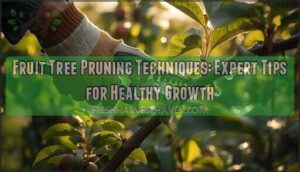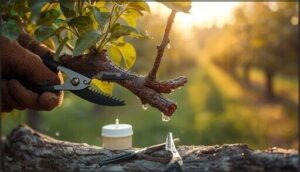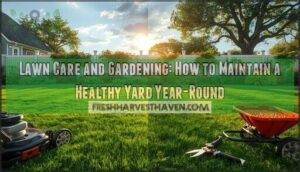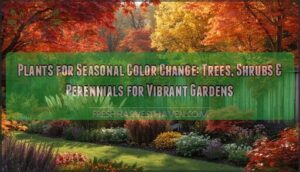This site is supported by our readers. We may earn a commission, at no cost to you, if you purchase through links.
A single pruning cut can mean the difference between a bumper harvest and a struggling tree. Every branch you remove—or leave behind—shapes how your fruit tree allocates water, nutrients, and energy for the coming season.
Yet many growers approach their apple, peach, or citrus trees with hesitation, unsure where to make that first cut. Proper fruit tree pruning techniques aren’t about hacking away growth; they’re about strategic decisions that boost fruit quality, prevent disease, and extend your tree’s productive life.
The fundamentals matter more than most gardeners realize, and mastering them transforms uncertain snipping into confident, purposeful shaping.
Table Of Contents
- Key Takeaways
- Why Prune Fruit Trees?
- Best Time to Prune Fruit Trees
- Essential Pruning Tools and Preparation
- Step-by-Step Pruning Techniques
- Advanced Pruning Methods for Yield
- Common Pruning Mistakes to Avoid
- Frequently Asked Questions (FAQs)
- How do you prune a fruit tree?
- Why should you prune a fruit tree?
- Should you cut off a fruit tree?
- When should I prune a fruit tree?
- How do you prune a landscape tree?
- Should you prune a tree?
- Should you prune your fruit trees?
- What are the best ways to prune a tree?
- How can pruning improve tree health and fruit production?
- How do you care for a fruit tree after pruning?
- Conclusion
Key Takeaways
- Strategic pruning during late winter dormancy directs energy toward fruit production, increasing yields up to 20% while reducing disease pressure by 40% through improved airflow and sunlight penetration.
- Proper technique involves removing dead wood first, cutting suckers and water sprouts flush at their origin, and making 45-degree angled cuts just outside the branch collar to promote fast healing without water pooling.
- Over-pruning more than 25-50% of the canopy in one season triggers severe stress, reduces cold tolerance, and can slash fruit yields by half, making gradual annual maintenance far more effective than aggressive cutting.
- Tool sterilization between cuts prevents spreading pathogens that infect up to 78% of pruned trees, while sharp blades create clean wounds that heal 66% faster than ragged cuts from dull equipment.
Why Prune Fruit Trees?
Pruning isn’t just about aesthetics—it’s one of the most powerful tools you have to tap into your tree’s full potential. When you cut strategically, you’re directing energy where it matters most: toward bigger fruit, stronger limbs, and a healthier canopy.
Strategic pruning directs your tree’s energy where it matters most—toward bigger fruit, stronger limbs, and a healthier canopy
Let’s look at the three core reasons pruning should be part of your annual orchard routine.
Benefits for Fruit Production
The relationship between strategic pruning and fruit production runs deeper than most orchardists realize. When you master pruning techniques, you’ll release significant tree health benefits and harvest efficiency:
- Fruit yield increase through ideal resource allocation—spring pruning can deliver yields up to 23.94 kg per plant
- Fruit quality enhancement as fewer fruits mature larger and sweeter
- Pruning for better yield by directing energy toward productive branches rather than water sprouts
Understanding the effects of pruning treatments is vital for maximizing fruit production.
Disease and Pest Prevention
Pruning for disease prevention cuts straight to the health of your orchard. When you remove infected wood and open the canopy, you’re disrupting fungal control issues like apple scab—research shows strong pruning reduces scab severity markedly.
Proper sanitation methods matter: sterilize tools between cuts to prevent spreading pathogens. Clean pruning wounds heal faster, blocking pest entry points while improving airflow that naturally suppresses brown rot and other disease pressures.
Effective pruning techniques involve understanding disease prevention strategies to maintain a healthy orchard.
Tree Structure and Growth Control
Beyond keeping pathogens at bay, you’ll gain control over how your tree grows and bears weight. Branch angles trained during early development prevent limb breakage under heavy loads—properly managed scaffold branches can extend tree lifespan substantially.
Canopy management through strategic pruning cuts shapes growth patterns into a strong, productive structure. Tree training establishes stable architecture that withstands seasons of abundant harvests without collapsing.
Best Time to Prune Fruit Trees
Timing can make or break your pruning efforts—cut at the wrong moment and you risk weak growth, disease, or lost fruit. Most fruit trees respond best to dormant-season pruning, but the ideal window shifts depending on whether your tree fruits on old wood or new growth.
Let’s break down when to prune based on season, tree type, and your local climate.
Dormant Season Vs. Growing Season
Timing separates great pruning from wasted effort. Dormant pruning during late winter maximizes new growth and minimizes disease risk, while cuts made during dormancy won’t exceed 25% of wood to avoid water sprouts.
Summer pruning suppresses root growth but enhances fruit color—though it increases fire blight risk.
Your pruning strategies must align with growth cycles and seasonal effects for peak fruit production.
Pruning by Fruit Tree Type
Different fruit tree varieties demand distinct pruning strategies matched to their growth patterns. Stone fruit trees—peaches, nectarines, apricots—bear on one-year wood, so you’ll apply open center pruning systems with 3–5 scaffold branches below one meter for light penetration.
Apples and pears tolerate central leader training at densities exceeding 1,000 trees per hectare, reaching full production within 3–5 years when you match pruning techniques to tree species.
Climate Considerations
Your local climate zone shapes every cut you make. In USDA Zones 2–4, prune during late winter after harsh cold passes but before buds swell—delaying until after the last expected frost can slash frost damage by 30%. Temperature extremes below freezing risk branch cracking.
Avoid rainfall effects by pruning in dry weather; wet cuts invite 65% more disease.
Drought management through strategic thinning reduces water demand by 28%.
Essential Pruning Tools and Preparation
Before you make the first cut, you need the right equipment in your hands. The tools you choose and how you maintain them directly affect your tree’s health and your own safety.
Let’s cover what belongs in your pruning toolkit and how to prepare it properly.
Choosing The Right Pruners, Loppers, and Saws
Your pruning success starts with proper tool selection. For branches under 3/4 inch, bypass pruning shears make clean cuts without crushing tissue.
Loppers with ergonomic grips tackle 3/4 to 1.5-inch branches efficiently.
When you’re facing anything larger—especially over 1.5 inches—reach for a curved pruning saw with seven to eight teeth per inch for smooth wounds that heal quickly.
Tool Sterilization and Maintenance
A contaminated blade can spread disease to 78% of newly pruned trees—making tool sanitization as critical as the cut itself. Alcohol-based disinfectants eliminate pathogens without the corrosion bleach causes, extending your pruner’s lifespan by 40%.
Your maintenance routine should include:
- Sterilizing pruning shears between trees with 70% isopropyl alcohol
- Sharpening blades every 18 months to guarantee clean cuts
- Cleaning sap and debris before applying disinfectant for maximum effectiveness
Safety Precautions for Pruning
Your safety gear matters more than you think—tree trimming carries a fatality rate 30 times the national average. Always wear long sleeves, sturdy gloves, and protective eyewear before handling pruning shears or a pruning saw.
Maintain three points of contact on ladders for fall prevention, and never work within 10 feet of power lines to avoid electrical hazards.
Step-by-Step Pruning Techniques
Now that you’ve gathered your tools and prepared your workspace, it’s time to put knowledge into action. The techniques you’re about to learn form the foundation of effective fruit tree care, guiding you through each essential cut with purpose and precision.
Let’s walk through the core methods that will transform your pruning from guesswork into confident, health-promoting practice.
Removing Dead, Diseased, or Damaged Wood
Your first line of defense against orchard disease starts with identifying compromised wood—look for discoloration, cracking, or bark abnormalities. You’ll want to prioritize deadwood management during dormant season pruning for disease prevention:
- Cut at least 8–12 inches below visible infection into healthy tissue
- Sterilize tools between cuts using 10% bleach solution for proper tree sanitation
- Remove all pruning debris immediately from your orchard
These wood removal practices reduce pathogen spread by up to 40%.
Cutting Suckers and Water Sprouts
Once compromised wood is cleared, turn your attention to vigorous vertical shoots that steal energy from fruiting branches. Water sprouts emerge from dormant buds on major limbs, while suckers rise from rootstock or trunk bases—both redirect nutrients away from your crop. You’ll achieve better fruit production by removing these annually, as they create canopy crowding that reduces flowering by up to 30%.
| Growth Type | Origin Point | Removal Timing | Regrowth Pattern | Management Strategy |
|---|---|---|---|---|
| Water Sprouts | Dormant buds on branches | Late winter preferred | High after heavy pruning | Thin and shorten rather than remove entirely |
| Root Suckers | Rootstock or tree base | Remove promptly when spotted | Recurs annually once established | Cut flush at origin point |
| Trunk Suckers | Main trunk tissue | During dormant season | Increases with scaffold removal | Annual removal prevents aggressive cuts |
| Weak Suckers | Lower trunk areas | Can delay 2-3 years | May form fruiting spurs | Evaluate productivity before removal |
| Stress-Induced Sprouts | Wound sites or cuts | Remove in growing season | Correlates with pruning severity | Use gradual pruning over 2-4 years |
Regular sucker removal limits leafhopper movement between trees, cutting disease transmission in your orchard. Dense, unpruned growth harbors overwintering pests and elevates fungal risk by restricting airflow—you’re looking at compromised fruit quality when these shoots persist. Studies confirm that consistent water sprout control improves both sugar content and color development in harvested fruit.
Your best approach? Remove suckers flush with the parent tissue using sharp bypass pruners, making clean cuts that heal quickly. For water sprout control, thin by spacing shoots apart rather than removing everything—this reduces the explosive regrowth that follows aggressive pruning. Trees maintained with routine attention display excellent yield and fruit quality compared to those pruned sporadically.
Don’t let these energy thieves undermine your orchard’s potential. Integrate sucker and water sprout management into your annual pruning routine, and you’ll maintain the structural balance that bolsters consistent, high-quality harvests for years to come.
Proper Cutting Angles and Multiple Cuts
After clearing unwanted growth, precision in cutting angle optimization and multiple cut techniques become your next frontier. A 45-degree angle aids wound healing processes and prevents water pooling that invites fungal infection. Branch collar preservation—that swollen ring where limbs meet the trunk—is non-negotiable; cuts respecting this zone compartmentalize decay effectively.
Master these three fundamentals with your pruning tools:
- Undercut first on branches exceeding one inch to prevent bark tearing during removal
- Finish outside the collar to support natural wound closure and tree pruning for fruit production success
- Sterilize between cuts using proper pruning tool selection and maintenance protocols
Shaping for Sunlight and Airflow
Once cutting angles are mastered, your focus shifts to canopy management and tree structure optimization. Open scaffold branches to increase light penetration—interior leaves need 30% full sun for proper fruit enhancement.
Remove competing limbs to boost airflow improvement by 60%, cutting disease pressure dramatically. Pruning strategies that balance sunlight penetration with air circulation transform dense canopies into productive powerhouses, delivering larger fruit and vibrant color development.
Advanced Pruning Methods for Yield
Once you’ve mastered the basics, you can refine your approach to optimize both yield and tree longevity. These sophisticated methods give you precise control over tree size, shape, and fruiting patterns.
Let’s explore techniques that professional orchardists rely on to balance productivity with manageable tree structures.
Drop Crotching for Height Control
When your fruit tree reaches skyward beyond comfortable harvest range, drop crotching offers the solution you need. This height reduction technique removes the main leader by cutting back to a healthy lateral branch—at least one-third the diameter of what you’re removing.
You’ll maintain structural integrity while improving canopy management and fruit accessibility. This pruning method controls growth without triggering excessive water sprouts, keeping productive wood within reach.
Bench Cuts for Lateral Growth
Redirecting vertical shoots horizontally transforms your tree architecture and improves fruit yield. You’ll cut upright branches back to lateral branching points at 45° to 60° angles, encouraging scaffold branches to spread outward rather than skyward.
This pruning technique opens the canopy for better light penetration and airflow while maintaining productive tree structure. Space bench cuts strategically during the dormant season to strengthen limbs without weakening overall canopy management.
Espalier and Training Systems
Espalier transforms confined spaces into productive orchards through deliberate tree training against flat frameworks. You’ll guide scaffold branches along horizontal wires or trellises, achieving yields up to 29.45 kg per tree while fitting three times more cultivars than traditional plantings.
- Establish support structures during initial two-to-five-year training periods
- Conduct four to six strategic pruning sessions annually to maintain form
- Monitor canopy development for enhanced airflow reducing disease incidence by 30%
This space optimization technique delivers fruit at eye level, cutting harvest labor by 40%.
Pruning Mature Vs. Young Trees
Tree age factors dramatically shift your pruning approach. Young trees demand annual structural work—removing up to 30% of the canopy—to establish proper tree training and development. Pruning after planting focuses on framework, not fruit.
Mature specimens need gentler handling: prune every two to three years, removing just 10-20% for maintenance. This difference in pruning intensity directly influences growth patterns, regrowth strategies, and ultimately, your fruit yield.
Common Pruning Mistakes to Avoid
Even experienced gardeners sometimes fall into habits that hurt their trees more than help them. Pruning is a skill that rewards precision and timing, but a few missteps can set your tree back an entire season.
Here are the most common mistakes you’ll want to steer clear of.
Over-Pruning Risks
Removing more than 50% of your tree’s crown in a single session is a recipe for disaster. This level of over-pruning triggers significant fruit yield loss—sometimes up to 50%—while increasing disease susceptibility through large wounds.
Your tree’s vigor plummets, cold tolerance drops, and sunscald becomes a real threat. The economic impact compounds over multiple seasons as recovery stalls.
Pruning at Incorrect Times
Timing isn’t just a detail—it’s everything. Pruning during active growth periods increases disease susceptibility and pruning stress, weakening your tree’s defenses. Late-season cuts promote tender growth that lacks cold hardiness, inviting frost damage when temperatures drop. Early pruning can trigger premature budding, exposing blooms to killing frosts.
Stick to the dormant season for structural work. Your pruning schedule directly determines whether you’re building strength or encouraging weak branching.
Ignoring Tree-Specific Needs
One-size-fits-all pruning is a recipe for disappointment. Each species demands attention to its unique tree anatomy and growth habits. When you prune fruit trees without species pruning knowledge, you’re inviting serious pruning errors:
- Cherries pruned like apples lose up to 28% of fruiting wood
- Peaches show 27% reduced fruit quality from improper shaping
- Pears experience 25% lower fruit set with wrong pruning techniques
Master each variety’s needs for better tree health and care, improved orchard management, and effective pruning for pest control.
Using Dull or Unsanitized Tools
Your pruning tools and equipment matter just as much as your pruning techniques. Dull blades create jagged pruning wounds that heal 66% slower, opening doors to tree infections and disease transmission. Unsanitized tools spread pathogens between cuts, potentially reducing fruit quality by up to 25%.
For proper tree health and care, sharpen blades regularly and practice tool sanitization between trees. Disease prevention starts with your equipment—don’t let pruning injuries sabotage your harvest.
Frequently Asked Questions (FAQs)
How do you prune a fruit tree?
You’d think leaving your fruit tree alone would keep it happy—ironically, that’s the fastest path to decline.
Fruit tree pruning basics involve removing dead wood, shaping for sunlight, and using proper pruning tools and techniques to boost production.
Why should you prune a fruit tree?
You prune to boost fruit quality, extend tree longevity, and prevent disease. Proper orchard management through strategic cuts promotes healthy growth, improves airflow, and directs your tree’s energy toward productive branches—essential fruit tree maintenance for abundant harvests.
Should you cut off a fruit tree?
You shouldn’t cut down the entire fruit tree unless it’s diseased beyond recovery or structurally unsafe.
Strategic pruning techniques and tree revitalization methods offer better alternatives for improving fruit yield and promoting healthy regrowth.
When should I prune a fruit tree?
Late winter timing isn’t just folklore—it’s biology. Your tree’s dormancy offers the safest pruning window, usually between January and March before buds swell, maximizing fruit yield while minimizing disease risk through seasonal cycles.
How do you prune a landscape tree?
Landscape tree care follows the same proven pruning techniques as fruit trees.
You’ll remove dead or damaged wood, thin crowded branches for airflow, and make angled cuts near branch collars using sterilized tools during late winter dormancy.
Should you prune a tree?
Yes, regular pruning techniques deliver real tree health benefits—stronger structure, better airflow, and increased fruit yield management.
These tree pruning methods support garden maintenance while building tree longevity strategies that keep your orchard productive for years.
Should you prune your fruit trees?
Absolutely. Regular pruning benefits your fruit trees by boosting yield up to 20%, preventing disease by 40%, and improving fruit quality. It’s essential tree maintenance that transforms your orchard’s productivity and health.
What are the best ways to prune a tree?
The best pruning methods involve removing dead or diseased branches first, cutting suckers and water sprouts, making angled cuts above outward-facing buds, and thinning dense areas to improve airflow and light penetration.
How can pruning improve tree health and fruit production?
Strategic pruning directs energy toward productive branches, increases fruit size by 10–15%, and reduces disease pressure by up to 60% through improved airflow and sunlight penetration—essential canopy management for growth optimization.
How do you care for a fruit tree after pruning?
The real work starts once your tools are down. You’ll need to maintain soil moisture near field capacity for thirty days post-cut, apply balanced fertilizer sparingly, sterilize wounds during dry weather, and monitor regrowth vigilantly.
Conclusion
The irony? Most growers fear removing too much when their trees actually need more courage, not more caution.
Fruit tree pruning techniques demand decisiveness—every strategic cut you make today translates to stronger scaffolds, healthier yields, and fewer disease battles tomorrow. Your shears hold more power than fertilizer ever will.
Trust the fundamentals, respect your tree’s biology, and prune with conviction. The harvest you envision starts with the branches you’re brave enough to remove.
- https://distantreader.org/stacks/journals/jhs/jhs-212.pdf
- https://growinginthegarden.com/when-and-how-to-prune-fruit-trees/
- https://extension.psu.edu/fruit-tree-pruning-a-rules-based-approach/
- https://attra.ncat.org/publication/pruning-for-organic-management-of-fruit-tree-diseases/
- https://oaj.fupress.net/index.php/ahs/article/download/2950/2950/2915












